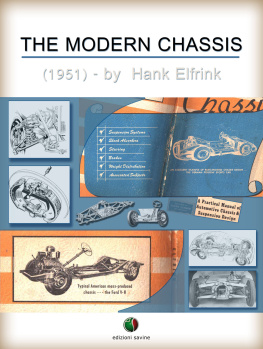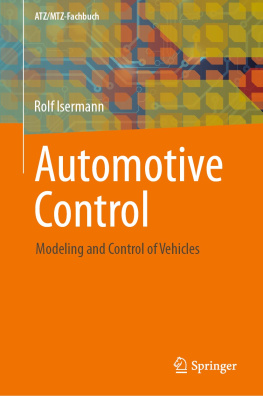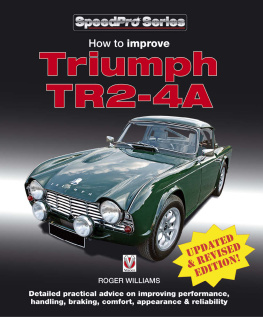New digital edition of:
The Modern Chassis
by Hank Elfrink
1951 by Floyd Clymer - Los Angeles
Copyright 2015 - Edizioni Savine
All Rights Reserved
Strada provinciale 1 del Tronto
64010 Ancarano (TE) Italy
email: info@edizionisavine.it
web: www.edizionisavine.com

ISBN 978-88-96365-71-7

CHAPTER 6 - STEERING
THE STEERING gear is one of the most important features of the car, as safe and dependable steering has made possible the high speeds of which modern cars are capable. Steering mechanisms must be accurate and steering wheel movements faithfully transferred to the front wheels. To secure this, lost motion or "springiness" in the pivot joints or interconnecting linkages should be kept at a minimum.
GEOMETRICAL PRINCIPLES
When turning a corner, the front wheels follow a pattern of two concentric circles (see Fig. 1). The drawing shows clearly that for true rolling, each wheel has to be a tangent at its circular path and consequently must be perpendicular to the radius of that curve. These facts make it necessary to swivel the front wheels by means of a geometrically correctly designed steering linkage. Undoubtedly the easiest method would be to use the old cart type steering system with central pivot, which on corners turns the whole front wheel assembly (axle with wheels and springs), about this pivot, always keeping the front wheels parallel (Fig. 2).

FIG. 1Sketch of normal automobile steering with individual wheel spindle pivots. Since each wheel must be perpendicular to its turning radius, wheels toe out on corners.
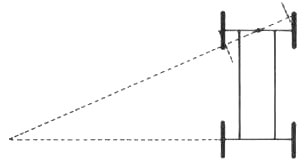
FIG. 2 Sketch of cart-type steering with central pivot. Although steering geometry is perfect for all steering angles, it is unsuitable for a fast motor vehicle, as explained in text.
Although this arrangement was satisfactory for slow horse-drawn vehicles and essentially geometrically correct for all steering angles, it is incompatible with the design of the modern highspeed vehicle; it would render the car unstable on sharp corners and on account of the considerable leverage around the central pivot, road shocks would impart too great an impact on the steering linkage.
ACKERMANN PRINCIPLE
The diagram shown in Fig. 3 is generally referred to as the Ackermann principle. The front wheels are situated on the short stub axles which can turn about the king pin. The two stub axles are linked together by the tie- or track rod, through the medium of the two short track rod arms (See also Fig. 8).
In the straight-ahead position, axle, track arms and track rod form a trapezoid, but when a corner is turned, axle and track rod no longer are parallel and the left track rod arm has turned through a greater angle than the right one. On a right-hand turn the right-hand track arm will be turned through a greater angle.
The Ackermann layout gives a fairly good approximation of the geometrical steering requisites; it is not absolutely true as in the case of the primitive cart steering. Theoretically it is only correct for small steering angles, and tire scrub occurs on sharp corners. However, since acute corners are seldom taken at high speed, the Ackermann linkage is quite satisfactory for the requirements of the average motor vehicle.
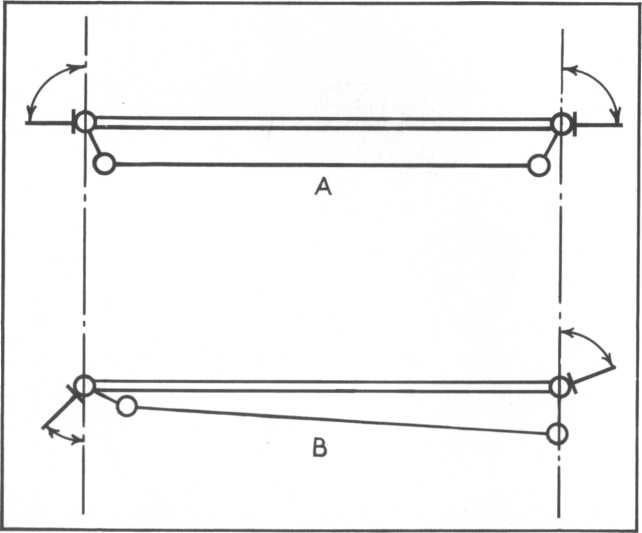
FIG. 3Ackermann layout of steering linkage to insure satisfactory steering geometry. By positioning the steering arms slightly inclined, a greater steering angle of the inner wheel spindle is obtained on corners. This simple Ackermann arrangement is geometrically correct only for small steering angles; however, discrepancies may be ignored for practical considerations. A. Straight-ahead position B. Position on corners.
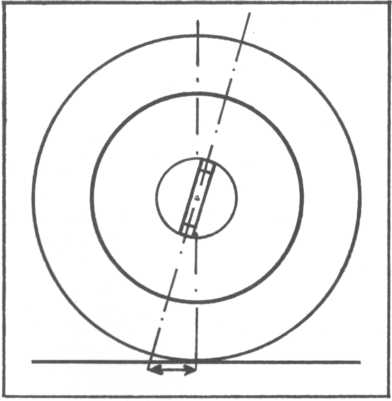
FIG. 4Principle of caster action, which, gives straight running tendencies and self - centering steering action.
CASTER
Other geometrical principles on which every steering layout is based are Caster and Camber.
Caster of the front wheels is obtained by tilting the king pin back a few degrees so that the imaginary center line of the king pin strikes the road slightly ahead of the point of contact of tire and road. (See Fig. 4.) This arrangement provides a certain self-centering action of the wheels, which means that they have an inherent tendency to return to the straight-ahead position after the turn is made.
CAMBER AND KINGPIN INCLINATION
Fig. 5 illustrates what is meant by camber and kingpin inclination. It shows the arrangement for true center-point steering, whereby the kingpin is inclined in such a way that its center line strikes the "point of contact of tire and road. Center-point or near-center-point steering is usually accomplished by inclining both kingpin and wheel. Too much tilt of the kingpin should be avoided, since it has undesirable effects on the steering and stability of the car. In the old daysbefore the adoption of front-wheel brakestrue center-point steering sometimes was effected by using a wheel with a pronounced dished shape (See Fig. 5), and positioning the kingpin right in the center line of the wheel. Advantages are that the wheel always remains in a vertical position no matter what steering angle is assumed. Disadvantages are that the kingpin and bushes are inaccessible, that the wheel spindle bearings are too far from the center line of the wheel, and protruding hubs are dangerous in traffic.
TRUE CENTER POINT STEERING
In any case, true center-point steering is rarely used nowadays since it gives the steering a rather dead feeling. A close approximation of the center-point steering principle is usually met by inclining both wheel and kingpin.
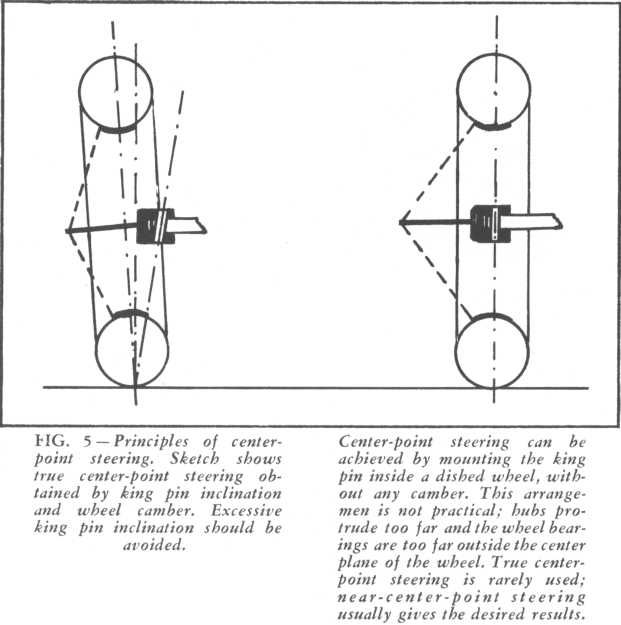
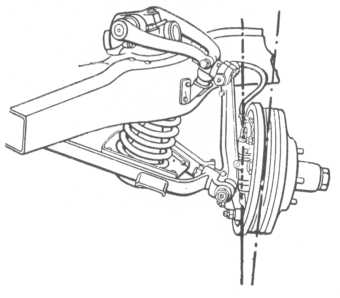
FIG. 6Near-center-point steering principle on normal wishbone system.
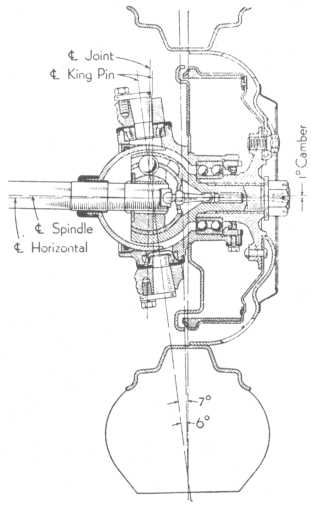
FIG. 7True center-point steering in Cord front -wheel-drive car. A Rzeppa constant-velocity joint is used.
Wheel camber decreases load on kingpin and bearing lock nut, shifts the load toward the inner front wheel bearing, and the wheel position conforms to the curvature of the average road. (See Fig. 6.)
True center-point steering may be encountered in front-drive cars (See Fig. 7), where the traction passes through the front wheels and where any excessive deviation from the center-point principle would tend to make the steering unstable and unsafe.
Next page
